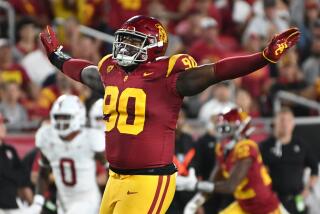Depth of Aztecs’ Problems Could Have Been Foreseen
- Share via
SAN DIEGO — The problem with the sagging San Diego State football team might not be as much one of performance as it is of perception.
Through spring practice, preseason camp and the early schedule, the Aztecs, especially Coach Denny Stolz, saw the glass as half full.
Only recently, after losses in 4 of the first 5 games, have some Aztecs begun to realize it’s really half empty.
The defense once again is among the worst in the country, the offense has struggled to find a rhythm and the kicking game has been erratic.
The warning signs were there, however. The Aztecs had plenty of reason to be skeptical about the task they faced.
They had lost punter Wayne Ross, who did not have a punt blocked in his four seasons. They would be without quarterback Todd Santos, who left after last season as the most prolific passer in major-college history. And they would be playing with a defense that mainly was a collection of converted offensive players and holdovers from a defense that ranked among the worst in almost every major-college category in 1987.
Considering that, maybe the Aztecs’ slow start is not a surprise. But those closest to the program saw and expected much more.
Stolz went as far as to sound surprised, if not a bit insulted, that fellow Western Athletic Conference coaches, in their preseason poll, picked his team to finish fourth in the nine-team league. Although he has tempered his enthusiasm somewhat, Stolz remains upbeat.
“I’m an optimistic person by nature,” he said this week. “I look at the good side of the ballclub. I’m not going to be pessimistic. I’m going to be optimistic about this year, next year and the year after that.”
Others, though, are beginning to pull back and realize that their goals will not be met this season.
“We had a good, strong spring practice, and based on those kind of things we make certain assumptions,” Athletic Director Fred Miller said this week. “We assumed we had created a basis for cautious optimism. Obviously that was a misnomer after the first five ballgames.
“We knew going in that UCLA (59-6 loss) would be a difficult ballgame, but we thought the next four football teams--Air Force (39-36 victory), Stanford (31-10 loss), Oregon (34-13 loss) and Wyoming (55-27 loss)--would be (competitive) football games. Those were not, and the result is what you see.
“We did not anticipate this kind of success ratio.”
What Miller means by success ratio is wins and losses. And so far, the Aztecs are 1-4. Last season, they started 1-6 on their way to a 5-7 record. The main problem again is defense.
As the Aztecs approach their homecoming game Saturday night against Hawaii at San Diego Jack Murphy Stadium, they are behind the pace they set last season when they finished 95th in total defense and 98th in scoring defense among the 104 NCAA Division I-A schools.
After five games, SDSU is 102nd in scoring defense (43.0 points per game), 102nd in rushing defense (303.6 yards per game) and 97th in total defense (466.4 yards per game).
But unlike last season, when they could rely on a strong offense to keep them in games, the Aztecs are having their difficulties on that side of the ball as well.
After finishing last season as the No. 2 passing offense and the No. 10 overall offense in NCAA Division I-A, the Aztecs are closer to the middle this time. They are 39th in passing offense (233.0 yards per game), 99th in rushing offense (94.2 yards per game) and 74th in total offense (327.2 yards per game).
“It might be a surprise, but I’m more foggy on where our offense is than our defense,” Stolz said. “We’ve been so far behind, we haven’t had a chance to see what we can do.”
Aztec quarterbacks have been sacked 24 times in 5 games, an average of once every 8.8 passing attempts. Brad Platt, Santos’ replacement, has taken the brunt of those hits. Last season, SDSU was sacked 40 times in a 12-game season, or an average of once every 13.7 passing attempts.
Even in the face of such numbers, Stolz has remained upbeat. The most criticism he would allow this week in discussing his offensive line was to say he was “disappointed” in their performance.
His move of Chuck Hardaway, a junior transfer from Taft College, into the starting left tackle position, the shift of junior Damon Baldwin to right from left tackle and demotion of junior Samida Tuiaana to a part-time player is a result of that disappointment.
But such admissions are few from Stolz. He has held this course for months despite signs that this team might have some problems, especially on defense.
The Aztecs tried to adjust by moving offensive players to defense. Six of the 22 defensive players on the Aztec two-deep roster started under Stolz on offense. These include three starters--inside linebacker Lee Brannon, nose tackle Brad Burton and end Mitch Burton.
They changed defensive coordinators, appointing Ed Schmidt, former offensive line coach, to replace Tim McConnell. And they changed defensive fronts, installing a 3-4 in place of the 4-3 they used last season.
The theory was that the Aztecs could better suit their personnel to this defense, which would be more effective against the pass-oriented teams the Aztecs expect to face in the WAC.
The theory has proved false on two counts. Teams have found it so easy to rush against the Aztecs that have hardly needed to pass, and the Aztecs have not had early success in finding impact players on defense.
The Aztecs spent much of last week preparing to face a passing Wyoming team. The Cowboys instead stayed mostly on the ground, rushing for 451 yards.
Dabby Dawson gained a fair piece of that, outrunning most of the Aztec secondary 86 yards for Wyoming’s first touchdown.
“We were hoping we could catch him, but apparently we weren’t fast enough,” Stolz said.
The play came against an Aztec blitz, a fairly frequent occurrence as the Aztecs have had to gamble on defense. But such risky tactics have netted them only four sacks.
“Our only sacks have come off the blitz,” Stolz said. “We’re not physical enough. If we stand still, we get knocked over, and if we blitz and they pick it up, we have a problem. We just have to get bigger.”
Injuries to several defensive players, including inside linebackers Brannon and Tracey Mao especially have hurt, Stolz said, because he does not have adequate replacements.
That points to what might be the biggest problem facing Stolz in his attempt to build a defense: The Aztecs have not had the kind of success they wanted recruiting defensive players.
Only 28 scholarship players brought in by Stolz and his staff as defensive players remain on the roster. That compares to 44 who were brought in as offensive players. Five of those have since been switched to defense.
“We can’t take a hit on defense,” Stolz said. “If we can get our defensive kids on the field--the 11 or 12 or 13 who can play at this level--we’ll be all right.”
Stolz repeatedly has referred to such roster problems as a result of taking over a team that lost 30 lettermen from his first SDSU team that won the WAC title in 1986. But what might be more ominous is that 16 of the 22 players on the defensive two-deep roster are in their junior or senior seasons of eligibility. That compares with 13 on offense. That means that in the next two seasons, the Aztecs again must quickly go about rebuilding the defense.
To do so, they will have to use either community college players--an area in which the Aztecs have had spotty success--or through high school recruiting. So far, the Aztecs’ efforts in that area have been heavily oriented to linebackers but only one--Mao--has stepped in and played as a freshman.
Stolz said before the season that he thought as many as three freshman linebackers might make the two-deep. The lack of immediate help has been a problem because the Aztecs went to a four-linebacker defense despite returning only three healthy players who lettered as linebackers.
That has left them to fill the void by converting players such as Sai Niu, a 5-foot 10-inch, 205-pound sophomore, from strong safety to inside linebacker. The result can be what happened against the Cowboys. Wyoming ran directly at Niu on Dawson’s long touchdown.
NOT MUCH PROGRESS SDSU statistical comparison after 5 games in 1987 and 1988; 4 opponents (UCLA, Air Force, Oregon and Wyoming) are the same. Utah (1987) was replaced by Stanford.
OFFENSE
Statistic 1987 1988 Record 1-4 1-4 Points/game 20.6 19.0 Rush yards/game 88.8 94.2 Pass yards/game 288.6 233.0 Total yards/game 377.4 327.2 Sacks allowed 10 24 Pass attempts per sack 23.4 8.8
DEFENSE
Statistic 1987 1988 Points allowed/game 41.4 43.0 Rush yards allowed/game 268.8 303.6 Pass yards allowed/game 225.2 162.8 Total yards allowed/game 494.0 466.4 Sacks made 11 4 Pass attempts per sack 11.9 29.3
More to Read
Go beyond the scoreboard
Get the latest on L.A.'s teams in the daily Sports Report newsletter.
You may occasionally receive promotional content from the Los Angeles Times.










